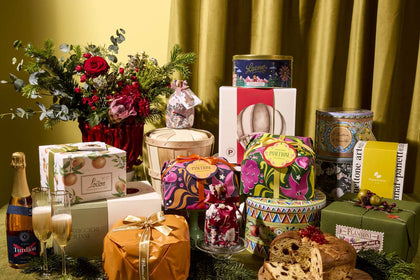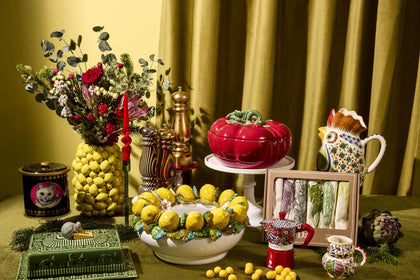
Pandolce Recipe - Italian Christmas Cake
by Valentina Harris
-
Easy

Browse hundreds of extraordinary Christmas food gifts at Sous Chef. Or for the foodie Christmas gift that every food-lover is hoping for, see our finest Italian panettone.
"Genoese tradition dictates that this cake is always brought to the table at Christmas by the youngest member of the family, who then ceremoniously places a bay leaf sprig in the centre as a symbol of well-being and fortune. The head of the family has to receive and cut the cake and then recite the traditional greeting in Genoese dialect:
I wish everyone good health,
for today and for tomorrow.
Let all those seated here
enjoy it in peace
with the young and the old,
with relatives and neighbours,
every year to come
as God would wish it to be.
Then the slices of cake are all carefully distributed within a precise order of precedence: the first slice is set aside for the first poor person who knocks on the door; the second is kept until February 3rd - the Saint’s day of St Biagio - protector of the throat; and the third slice is for the mother, or at least for whoever prepared the Pandolce - and thereafter everyone else finally get their piece!
Shop all Italian food & ingredients here
According to some, the creation of this cake was the result of a competition amongst pastry chefs held in 1500 by the Genoese Doge Andrea Doria. The challenge was to create a cake that represented the richness and magnificence of Genoa but that at the same time would keep long enough to be taken on those long sea voyages.
It certainly is a cake with a long shelf life, it is still good 2 months or so after baking if kept in an airtight container.
Another source claims it was first served at the table of none other than my ancestor the famous crusader Ludovico il Moro, Duke of Milan from 1489 to 1508 whilst on a visit to Genova, and that it was derived from a recipe for a Persian cake made with pine nuts, sultanas, candied fruit and other exotic ingredients that flowed into the port as a result of the crusades and the surrounding trading that evolved.
Whether any of these stories are true or not, for centuries Pandolce has appeared on the tables of Genoese families every Christmas."
This recipe is by Valentina Harris. See more of Valentina's Italian Christmas recipes plus classic Italian dishes such as homemade pasta.
Ingredients for Pandolce
- 375g unsalted butter - at room temperature
- 300g of granulated sugar
- Seeds scraped from 1 vanilla bean
- 2 large free-range eggs
- 200ml full fat milk
- 65ml orange blossom water
- 1kg + 125g of plain white flour
- 18g baking powder
- 1/2tsp ground coriander
- 1tsp fennel seeds
- 100g pine nuts
- 375g candied orange peel, chopped
- 875g raisins, soaked for about 30 minutes in warm water until plumped up, then drained thoroughly
- Extra flour for dusting
How to make Pandolce
- Cream the butter with the sugar and vanilla seeds, then add the eggs one at a time and combine, so that the eggs are incorporated perfectly and the dough is slightly whipped.
- In a small saucepan, heat the milk with the orange blossom water (ideally 40°C). If it is too hot, the dough will remain too soft, if it is too cold the dough will remain too hard and therefore difficult to shape.
- Add the milk to the mixture and then immediately after add the flour, baking powder, coriander and fennel seeds.
- Mix for about 5 minutes and then add the pine kernels, candied orange and the raisins. Mix again to combine all the ingredients thoroughly.
- Preheat the oven to 200°C/400°F/Gas Mark 6/180°C Fan. Tip the dough out on to well-floured work surface and divide into 6 roughly equal pieces.
- Take each piece and roll with your hands on a floured work-surface to form 6 smooth, rounded loaves. Be careful not to allow the fruit to come through the surface, as it may burn or fall off during baking.
- Put the round loaves on baking sheets covered with parchment paper, leaving a space of about 6cm in between them (you will need 2 baking sheets of 30x40cm or do this in two or more batches).
- Slightly flatten the dough with the flat of your hands and mark a little triangle on the surface by snipping the dough with a pair of scissors.
- Bake for 40 minutes or until a skewer inserted into the centre comes out perfectly dry.
- Allow to cool completely on wire racks before serving. If you keep them for 3-4 days they will taste even better as all the flavours will really develop. In an airtight container they should keep well for at least 2 months.


About the author
Valentina Harris is a passionate Italian cook and award-winning author with more than 30 books to her name, including The Italian Regional Cookbook; Risotto! Risotto!; Classic Recipes of Tuscany; 500 Italian Recipes, and Valentina Harris’s Complete Italian Cookery Course. Educated in Italy, Valentina brought her qualifications for teaching and cooking from Rome to London in 1976. As a regular face at food festivals in the UK, Valentina stills finds time to share her expertise and love of Italian food by hosting courses, plus can be found regularly contributing to radio, TV, newspapers, and magazines.


